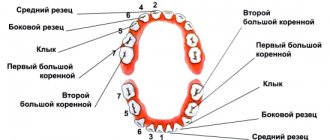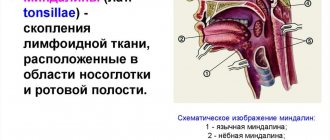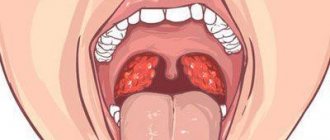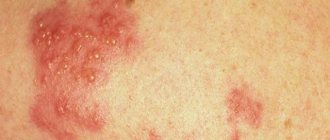Dental practice has extensive experience in treating oral diseases. Moreover, therapeutic measures are aimed not only at eliminating diseases that manifest themselves in bone tissue, but also at problems with the gums.
A fairly common and dangerous problem in this area is such a pathology as pus on the gums of a child. Such a pathology should seriously alert parents and prompt them to seek immediate help, since otherwise it can cause serious complications.
Possible causes of gum suppuration
Quite often, pathology occurs as a result of tooth damage due to caries. We recommend that you carefully read the material:
Caries in a child: types, symptoms, treatment, photos
The initial stages of the process usually do not cause any particular discomfort - the abscess on the child’s gum does not hurt, and no changes in the child’s behavior are observed.
This condition allows the infection to penetrate deep into the enamel, causing increasing damage to the tooth. Having reached the root, the infection spreads to the soft tissues, causing inflammation.
Since the inflammatory process is caused by bacteria, pus begins to accumulate inside the gum tissue. Reaching its apogee, the purulent accumulation becomes noticeable under the mucous membrane of the gums in the form of a white or yellowish sac.
The most common causes of pathology are:
- formation of pulpitis as a result of lack of treatment of caries on baby teeth;
- medical error (installation of filling material on an untreated tooth);
- infection in soft tissues (an abscess on the gum during teething may appear due to the child biting poorly disinfected rubber toys or special teethers);
- untreated pulpitis of the permanent tooth;
- infection as a result of damage to the gums by a foreign body.
Infection of the gum tissue can be accompanied by pronounced symptoms, in which the child experiences severe discomfort.
How does a purulent lump develop?
In most cases, ulcers on a child’s gums appear due to caries. At an early stage, no symptoms occur, so the infection penetrates inside the tooth. When it gets to the root, toxins will begin to penetrate the tissue, causing swelling of the gums. Since the cause is bacteria, during the inflammatory process a purulent sac is formed, which is soft to the touch.
This swelling is clearly visible on an x-ray, and you can also see the area of inflammation in the bone tissue of the tooth. Without proper treatment, the amount of pus inside the mass will increase until it bursts. After this, at the site of the swelling, a hole will appear in the gum, connected to the inflammatory focus.
When the inflammation passes, the fistula will heal, but every time the immune system weakens or the slightest infection occurs, a purulent lump may form again.
READ ALSO: Abscess on the lower eyelid: causes of appearance, removal
Symptoms of diseases
Pus on a child’s gums cannot go away without treatment. Before applying therapeutic measures, the child feels swelling in the gums, after which after some time the area affected by bacteria turns red and swells. A gradual increase in size of the swelling leads to the formation of a white dot in the central part of the tumor. This indicates the presence of an abscess in the gum tissue. Upon palpation, you can find that the lump is quite soft and causes serious pain in the child.
Other symptoms accompanying purulent inflammatory process of the gums are:
- increase in baby's body temperature;
- capricious behavior, anxiety, sleep disturbance;
- decreased appetite (the baby refuses to eat, subconsciously trying to avoid additional pain).
If even a small abscess on a child’s gum is left unattended, serious complications of the pathology should be expected.
Memo to parents
The child's health depends on regular parental monitoring. To protect your baby from oral diseases, you must follow the following rules:
- Include plenty of fresh vegetables and hard-skinned fruits in your diet.
- Reduce your intake of easily digestible carbohydrates.
- Brush your teeth 2 times a day with sweeping movements “from the gums to the cutting edge of the tooth.”
- Visit the dentist once every 6 months.
- If there are any suspicious changes in the oral cavity, contact your dentist immediately.
If a lump has formed on your child’s gum, do not panic. Timely treatment of the disease leads to a quick recovery, and compliance with preventive measures ensures the preservation of dental health for a long time.
Bibliography
- Ed. prof. L.P. Kiselnikova - Pediatric dentistry, M.: GEOTAR-Media, 2014.
- L. S. Persin, V. M. Elizarova, S. V. Dyakova - Pediatric Dentistry, M.: Medicine, 2006.
- Ralph E. McDonald, David R. Avery, Jeffrey A. Dean - Dentistry For The Child And Adolescent - Mosby - 2004
- V. A. Zelensky, F. S. Mukhoramov. - Pediatric surgical dentistry and maxillofacial surgery, M.: GEOTAR-Media, 2008.
- Maksimovsky Yu.M. – Therapeutic dentistry, Textbook, M.: Medicine, 2002.
- Murovyannikova Zh.G. – Dental diseases and their prevention, Rostov n/a: Phoenix, 2011.
Read related posts:
Possible complications
Ignoring the purulent process occurring in the baby’s gum tissue will lead to the fact that, having reached a strong tension of the mucous membrane, it will break out, forming a fistula . They wrote about it in detail here:
Fistula on the gum in a child: photos, causes, possible complications, treatment
The baby’s condition will improve, the temperature will subside, but the accumulated pus will escape into the oral cavity, which will lead to further spread of the infection. Despite the fact that the fistula can resolve itself, reduced immunity can provoke the development of serious diseases.
If the infection begins to develop in a baby tooth, it can spread to the buds of a permanent tooth. The entry of bacteria into the mucous membrane of the tonsils provokes the development of lymphadenitis.
The formation of a purulent fistula also provokes the development of an allergic process in the body. And if pus gets into the bloodstream, the process of suppuration of other organs and tissues may begin. In this case, the formation of phlegmon and inflammation of the bone tissue of the oral cavity is possible.
The most correct decision when a child discovers an abscess on the gum is to go to a dental clinic.
The doctor will provide the following medical assistance:
- conduct a general examination of a small patient;
- will reveal the stage of the pustular process;
- will prescribe appropriate treatment.
If the abscess goes away without treatment, the child still needs to be shown to the dentist to avoid possible complications.
How to treat an abscess on a child’s gum?
The first thing to do is contact a dentist, since only he can assess the condition of the tooth. The specialist will prescribe effective therapy and stop the process of spreading pus.
It should be noted that the treatment of permanent and baby teeth is slightly different. For example, if an abscess appears in the area of a baby tooth, the latter is immediately removed. They resort to this measure due to the fact that it can infect the buds of permanent teeth located around it. In addition, the lymph nodes can also be damaged. Inflammation in them or the tonsils leads to the development of chronic tonsillitis.
Eliminate ulcers on a child’s gums in the following way:
- first, the dentist carefully examines the area where the lump is located;
- then he numbs the affected area;
- after these manipulations with special instruments, the doctor opens the abscess;
- then the specialist cleans the cavity from the accumulated purulent mass and treats the affected area with an antiseptic.
READ ALSO: Proper treatment of acne: effective methods and remedies for acne
If necessary, the doctor may prescribe antibiotics. If the inflammatory process has progressed far, the tooth will most likely be removed.
Treatment of the inflammatory process
If a white abscess has formed on a child’s gum, the dentist numbs the affected area of mucous tissue, opens it, causing the pus to drain out.
After this, a procedure is carried out to remove the baby tooth, which caused the purulent inflammatory process. After this, the patient is prescribed antibiotics and rinsing the mouth with antiseptic drugs.
If an abscess has formed under a permanent tooth, the doctor administers anesthesia, opens the affected area, and installs drainage to drain the pus. If the pulp becomes infected, it is removed and the bone tissue is filled.
If it is not possible to see a dentist in a timely manner, parents should take the following measures:
- at elevated temperatures, give antipyretic drugs;
- prepare a decoction of chamomile or sage and let the child rinse his mouth;
- apply cold to the sore spot;
- do not allow eating hot and cold foods;
- often give the child boiled water;
- do not touch the abscess and do not allow the child to do this;
- If the baby's condition worsens, you should call an ambulance.
To prevent such a purulent process, parents should carefully monitor the hygiene procedures of the baby’s oral cavity. You need to explain to him how to brush his teeth correctly, control the frequency of the procedure, which should be done twice a day.
You should also undergo a preventive examination with a dentist twice a year in order to promptly eliminate any problems that arise.
How to help a child with such an illness?
If a child has an abscess on his gum, not everyone knows what to do in such a situation. The first thing you should do if you notice a lump on your gum is to see a doctor. But before seeking medical help, you should not squeeze, puncture or burn abscesses on your child’s gums. They should not be touched at all, so as not to cause additional infection.
READ ALSO: Antibiotics for furunculosis: TOP 20 most effective drugs
There is no need to apply bags of heated salt or a heating pad to the swelling on your baby’s gums. Hot compresses and rinses are also not recommended, since heat will only accelerate the spread of bacteria. A child with such a problem should not be given any medications, especially antibacterial ones.

Reasons for appearance
The reasons for its formation are different. It can appear due to improper dental treatment. For example, after tooth extraction, if infection gets into the wound.
Pathogenic bacteria enter the upper part of the tooth. The bubble may become inflated due to caries, pulpitis or periodontitis. Caries destroys the tooth from the inside. With periodontitis, the infection comes from the teeth or maxillary sinuses. With untreated caries, complications are possible.
Read also: How to clean plaque on a child’s teeth
A purulent bubble is dangerous. Its contents can reach the pulp, and then the infection can penetrate the tissue around the tooth. As long as there is outflow in the channel, a bubble does not form. If the outflow is closed and microorganisms have accumulated there, then a growth forms on the gum in the form of a bubble.
HIV, tuberculosis or chronic hepatitis can contribute to the appearance of blisters. It happens that blisters on the gums appear due to burns from hot food. To establish exactly why such a formation appeared, a laboratory study of scraping from the surface of the bubble and its liquid is necessary.
In 50% of cases, the appearance of such formations is associated with herpes. It can occur in patients of any age group. A characteristic sign of herpes is a sharp increase in temperature. Blisters appear on the inside of the cheeks or on the gums. They are filled with cloudy or clear liquid. Pain is felt when eating or touching. Later, the bubbles open, forming red wounds.
Viral pemphigus occurs after tonsillitis, flu, tonsillitis. The rash on the gums is abundant, it can spread to other parts of the patient’s body. Due to intoxication, the temperature rises. A bubble on the gum sometimes forms when injured by sharp objects and hard foods. If the bubble remains on the gum for several weeks, this indicates a chronic manifestation of the disease.
Precautionary measures: what should not be done if an abscess appears on the gum
Today you can hear a lot of advice on how to get rid of this or that disease. However, they are often not suitable for everyone. The best treatment method is the one recommended and carried out by the doctor. Therefore, you should not succumb to untested methods and medications.
In order to avoid the unpleasant consequences of the development of an abscess on the gum, it is recommended to adhere to certain rules of behavior:
- Ensure proper oral hygiene in order to reduce the number of pathogenic microorganisms if the reaction development process is maintained.
- Periodically apply a cold compress from the side of the cheek to the affected area.
- Rinse frequently with antiseptic solutions. If you don’t have anything at hand, you can use regular potassium permanganate.
- For severe pain, you can use Analgin. It is worth considering that it will only bring temporary relief. If possible, you should contact your dentist as soon as possible.
When a purulent sac appears on the gum, you should not hope that the problem will go away on its own. Available remedies usually alleviate the symptoms, but the problem requires the intervention of a specialist. The diseases that cause the appearance of an abscess can be quite serious, requiring long-term treatment, and many preventive measures in the future.











